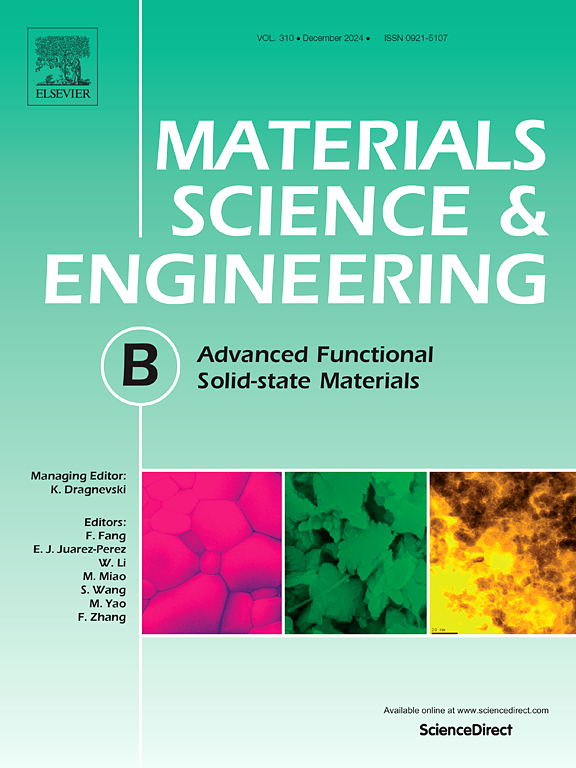含 Fe3O4 的还原膨胀氧化石墨的微波吸收特性
IF 4.6
3区 材料科学
Q2 MATERIALS SCIENCE, MULTIDISCIPLINARY
引用次数: 0
摘要
膨胀石墨(EG)因其巨大的表面积、低密度和多孔结构而被认为是一种吸收电磁能的优质材料。然而,阐明表面官能团、缺陷、导电性和氧化还原过程对电磁波吸收性能影响的研究仍然相对较少。在本研究中,首先使用优化的汉默法合成了不同程度的氧化膨胀氧化石墨(EGO),在引入含氧官能团后,EGO 表现出更强的极化和介电弛豫效应。随后,使用 L-抗坏血酸制备了不同还原度的还原膨胀氧化石墨(REGO),其中含氧官能团的去除导致空位缺陷的形成,从而增强了 REGO 的介电弛豫行为。最后,通过水热法和冷冻干燥法合成了 Fe3O4/REGO (FR) 复合材料。Fe3O4 和 REGO 之间的协同作用改善了磁性和介电损耗特性,并增强了阻抗匹配。研究结果表明,FR-3 试样在频率为 16.10 GHz 时的最小反射损耗为 -50.78 dB,厚度为 2.3 mm 时的有效吸收带宽 (EAB) 为 5.26 GHz。这项研究为电磁波吸收材料的未来应用提供了强有力的支持。本文章由计算机程序翻译,如有差异,请以英文原文为准。
Microwave absorption properties of reduced expanded graphite oxide with Fe3O4
Expanded graphite (EG) is distinguished as a superior material for the absorption of electromagnetic energy, attributable to its significant surface area, low density, and porous architecture. However, research elucidating the impact of surface functional groups, defects, electrical conductivity, and oxidation–reduction processes on the absorption performance of electromagnetic waves remains relatively scant. In this study, various degrees of oxidized expanded graphite oxide (EGO) were initially synthesized using an optimized Hummer’s method, which, upon the introduction of oxygen-containing functional groups, exhibited enhanced polarization and dielectric relaxation effects. Subsequently, reduced expanded graphite oxide (REGO) with varying degrees of reduction was prepared using L-ascorbic acid, wherein the removal of oxygen-containing functional groups led to the formation of vacancy defects, thereby enhancing the dielectric relaxation behavior of REGO. Ultimately, Fe3O4/REGO (FR) composites were synthesized via hydrothermal and freeze-drying methods. The synergistic interaction between Fe3O4 and REGO led to improve magnetic and diel ectric loss characteristics, as well as enhanced impedance matching. The findings reveal that the FR-3 specimen exhibited a minimum reflection loss of −50.78 dB at a frequency of 16.10 GHz, coupled with an effective absorption bandwidth (EAB) of 5.26 GHz at a thickness of 2.3 mm. This study provides robust support for future applications of electromagnetic wave absorbing materials.
求助全文
通过发布文献求助,成功后即可免费获取论文全文。
去求助
来源期刊

Materials Science and Engineering: B
工程技术-材料科学:综合
CiteScore
5.60
自引率
2.80%
发文量
481
审稿时长
3.5 months
期刊介绍:
The journal provides an international medium for the publication of theoretical and experimental studies and reviews related to the electronic, electrochemical, ionic, magnetic, optical, and biosensing properties of solid state materials in bulk, thin film and particulate forms. Papers dealing with synthesis, processing, characterization, structure, physical properties and computational aspects of nano-crystalline, crystalline, amorphous and glassy forms of ceramics, semiconductors, layered insertion compounds, low-dimensional compounds and systems, fast-ion conductors, polymers and dielectrics are viewed as suitable for publication. Articles focused on nano-structured aspects of these advanced solid-state materials will also be considered suitable.
 求助内容:
求助内容: 应助结果提醒方式:
应助结果提醒方式:


